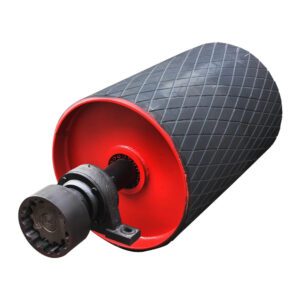What Is a Conveyor Drum? Complete Guide + Expert Sales and Repair
The conveyor drum is one of the key components of material handling systems. In this article, we explore the types of conveyor drums, their applications, how they work, and important tips for buying and repairing them.
Conveyor systems are among the most widely used equipment in various industries such as mining, steel, cement, agriculture, and packaging. A crucial component of these systems is the conveyor drum (also known as a pulley), which plays a vital role in the movement and tensioning of the conveyor belt. Understanding how drums function, their types, and the essentials of repair and replacement can help increase system lifespan and reduce maintenance costs.
What Is a Conveyor Drum?
A conveyor drum, or pulley, is a cylindrical metal component over which the conveyor belt rotates. It provides guidance and tension for the belt, helping it move along its designated path. Drums are typically installed at both ends of the system and are classified based on their function.
Types of Conveyor Drums
-
Drive Pulley
Usually located at the head (start) of the conveyor system and connected to the motor. Its main job is to create the traction force needed to move the belt. -
Tail Pulley
Positioned at the end of the conveyor, this pulley helps maintain proper belt tension and alignment. -
Snub Pulley
Used to increase the contact angle between the belt and the drive pulley, improving power transmission efficiency.
Drum Materials and Coatings
Conveyor drums are typically made from high-grade steel. To prevent belt slippage and increase friction, the surface may be coated with rubber or ceramic lagging.
Applications of Conveyor Drums
-
Mining and crushing industries
-
Food and pharmaceutical industries
-
Packaging plants
-
Steel and cement factories
-
Industrial assembly lines
Key Considerations When Buying a Conveyor Drum
-
Compatibility with belt width
-
Motor power and torque requirements
-
Body material and surface coating
-
Drum diameter and wall thickness
-
Installation and maintenance method
Conveyor Drum Maintenance and Repair
If your conveyor system is producing unusual noise, vibration, or reduced performance, the problem may lie in the drum. It’s essential to inspect bearings, shaft alignment, surface coating, and mechanical connections. For any drum repair or replacement, be sure to use experienced technicians and genuine parts.
Conclusion
The conveyor drum is a critical component in material handling systems, and selecting the right drum with proper maintenance has a direct impact on production performance. If you are looking for high-quality and cost-effective conveyor drum sales or repair services, feel free to contact our expert team.

